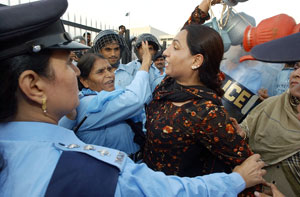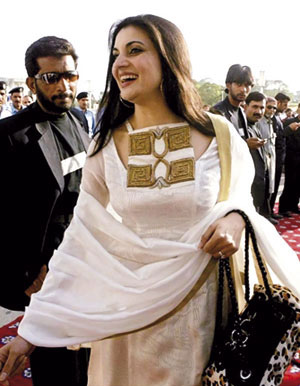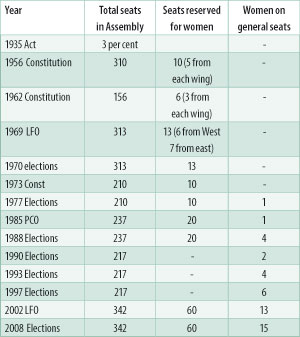One Step Forward
By Zubeida Mustafa | News & Politics | Published 15 years ago
At the recent ASR conference in Lahore on the women’s movement in Pakistan, I met a female journalist from a local Urdu language newspaper who was there to cover the opening event. She had not received her salary for two months. She tellingly asked me, “Now that women have such a substantial presence in parliament, do you think the goals of the women’s movement have been met?”
I couldn’t quite decide if she was being cynical or naive. Not wanting to offend her, I gave her a straightforward reply that winning seats in the assemblies was only a means — a very important one — to the end of winning women’s rights. The end still has to be achieved.
The large representation of women in the National Assembly, the senate and the provincial assemblies today is, however, in itself a significant development, considering that politics was more or less a no-go area for them just a few years ago. Another important aspect is that more women activists and professionals have been appointed to key posts than before. In other words they have a mind of their own and are capable of taking an independent stand on important issues. They should not be expected to toe the male line just because they are asked to.
This sea change in the composition of the elected bodies has been reflected in their public image as politicians. When Benazir Bhutto returned to Karachi on October 18, 2007, after a self-imposed exile of nearly a decade, she vindicated the general expectations in the country that women were quite capable of holding their ground in politics. After all, hadn’t she negotiated skilfully on an equal footing with an army general, an opposition leader from the biggest province and clerics heading religious parties? She had also been fearless.
Today’s situation is a far cry from the times when politics was a preponderantly male preserve in Pakistan. The few women who managed to enter its sacred precincts did so by virtue of their male connection that privileged them and endowed them with a right of entry where others feared to tread. Whether it was Miss Fatima Jinnah, who challenged Pakistan’s first military dictator, or Benazir Bhutto, who emerged as the first woman prime minister in the Muslim world, each owed her initiation into politics to the political legacy she inherited.
 But that was a past era. Today the dynasty factor is no longer the only key to success in politics and women are now making their way to key positions on their own merit.
But that was a past era. Today the dynasty factor is no longer the only key to success in politics and women are now making their way to key positions on their own merit.
But where women still lag behind is in their ability to compete on an equal footing with men. They still need the prop of reserved seats to be elected to parliament in numbers that are impressive enough. The women’s movement pushed the constitutional device of reserved seats for women as ‘affirmative action’ and thus opened the door to female participation in politics in larger numbers. Moreover, the realisation has grown that without political power women will continue to be denied access to national policy making considered so essential to protect their status.
The women’s demand for a political role led constitution-makers to earmark some seats for women lawmakers. Initially, conceding to this demand may have been designed to showcase the female presence but it generated its own momentum and an increase in numbers became inevitable in the coming years. (The table below shows how the number of seats reserved for women in parliament has steadily increased).
Traditionally, Pakistan’s patriarchal society has not been kind to women who have had to wage a struggle to assert themselves to make their mark in politics. But have they fared better in other sectors? The issue must be seen in a holistic perspective. It is unrealistic to expect women to win their political spurs and gain enough representation in parliament when at the national level their status continues to be dismally low. But conversely, better female representation should help improve the status of women.
More women appeared on the political scene after Musharraf opened the door for them. The 1973 constitution had earmarked the seats for women for two elections/10 years. As a result there were no reserved seats in the assemblies that functioned from 1990 to 2002 and female participation in law-making had become minimal. A new trend was reflected in the local governments where the women’s presence became quite substantial after 2001 when 33% of seats were reserved for them in the union, tehsil, town and district councils. Although in some areas of the NWFP there was strong resistance to female participation in elections, the response was surprisingly good in other regions. Over 36,000 women got elected to the union councils in 2001. In 2005, the figure however dropped to 28,000.

Kashmala Tariq
The question to be asked is why an army strongman, determined to perpetuate his power, should decide to make the female presence so visible in various elected bodies. It is not that President Musharraf was a champion of women’s rights — his most quotable quote was that women got themselves raped to obtain a visa to Canada. Nor was he a democrat. One reason could be his desire to project a liberal image of himself as a modern and progressive man, willing to break all barriers of conservatism. It may be recalled that within a few months of taking over office he called a convention on women and with great fanfare announced the establishment of the National Commission on the Status of Women in 2000. Next came the increase in women’s seats in the local bodies. The reserved seats in the assemblies were also raised.
The second reason could be that Musharraf misread the potential of woman power in politics and believed women would be easier to manipulate. But now we know his confidence was misplaced.
The substantial presence of women in politics may not have created the critical mass needed to influence decision-making conclusively. A disadvantaged section of the population has yet to break out of its marginalisation. But the 231 women in the various assemblies and the senate (there were 232 in the previous one) cannot entirely be ignored or manipulated.
Have women made an impact on policy making? This is the issue being hotly debated in Pakistan today. There are some who openly express their anger and disappointment at the “failure of the women parliamentarians to change the situation for women” generally. They feel that these parliamentarians have surrendered their privileges and powers to their male electors. They add, “They vote along party lines because they do not want to tread on male toes and prefer silence to protestations. They forget that they are representing the interests of women.”
What is actually forgotten is that our women MPs do not have much room to manoeuvre thanks to their mode of elections. Elected indirectly by the National Assembly’s representatives — mainly men — they have to submit to the party agenda. There is no room for independent candidates to fill the reserved seats. The system of dual voting for women provided by the 1956 constitution — one for the general seats and the other for the reserved seats — was not adopted by the constitutions that followed. If women MPs go against the party discipline their future is doomed.

Representation of women in parliament in Pakistan.
They have chosen to negotiate their way around the barriers they meet and have succeeded in some ways. By setting up a women’s caucus — probably the first of its kind in Pakistan’s constitutional history — they try to engage their colleagues from other parties and through them they attempt to reach out to all lawmakers. Women parliamentarians have performed reasonably well, considering that this is a new area of activity for them. An Aurat Foundation report, “Women Parliamentarians in the 12th National Assembly (2002-2007),” gives comprehensive data documenting the role of women in five years of the assembly’s life. Compared to their male colleagues they have been more serious in performing their duties as legislators. They were more regular in attending sessions and in some cases their interventions exceeded their ratio (21%) in the composition of the house. Thus women MPs moved 42% of the private member bills and 30% of the resolutions.
Another NGO, FAFEN (Fair and Free Elections Network) reported similar findings when it wrote about the 18th session of the NA held in January 2010: “Female members continued to show more interest in parliamentary proceedings. Out of 18 private member bills tabled, 12 were laid before the house by female members.”
The growing impact of women has also begun to be felt on lawmaking on women’s issues in recent times. It is no coincidence that more laws addressing women’s concerns are being taken up by the NA and the senate. Be it the Protection of Women’s Act, 2006, the Criminal Law (Amendment) Act 2010 against harassment, the Criminal Law (Amendment) Bill 2004 against ‘honour’ killing, and others owe their passage to the support they received from women. True, some fall short of women’s expectations — the Domestic Violence Bill was not taken up by the senate in time after its adoption by the National Assembly — but one cannot deny that women MPs are making a difference in the attitudes of lawmakers.
There are still complaints of men not showing the respect they are expected to show their female colleagues, even on the floor of the house. Male parliamentarians are not always sensitive to women’s concerns when it comes to lawmaking or taking a stand on issues of direct relevance to women. But the sea change in the attitude of women themselves — they are more confident and assertive — has forced male perspectives to shift.
Read Newsline‘s interviews with five women parliamentarians:
Zubeida Mustafa is a senior journalist. She writes on a variety of subjects but her interest has mainly been in the social sector which she has covered extensively. She has investigated in-depth issues such as education, health care, women’s empowerment, children’s rights and the lives of ordinary people.


